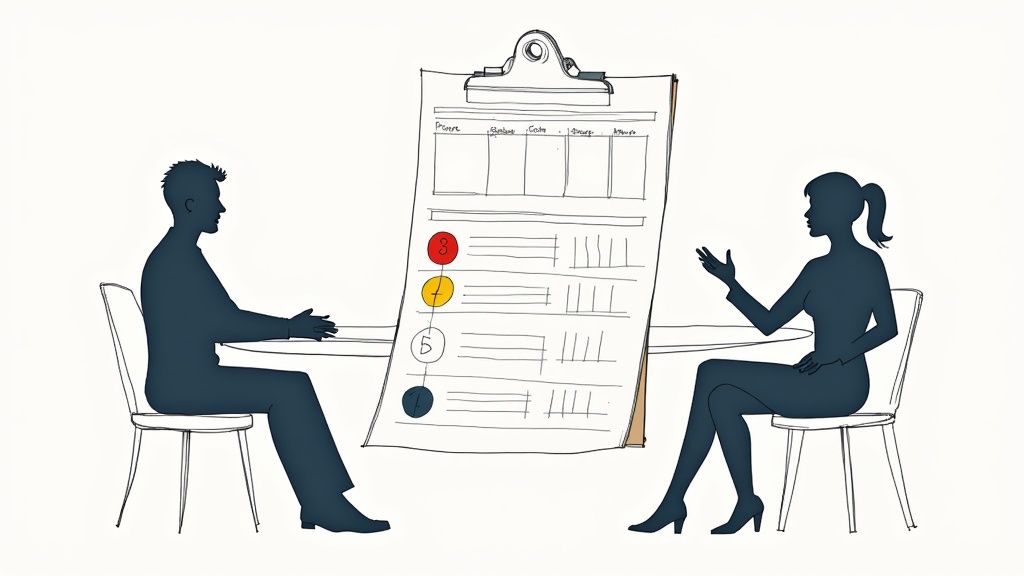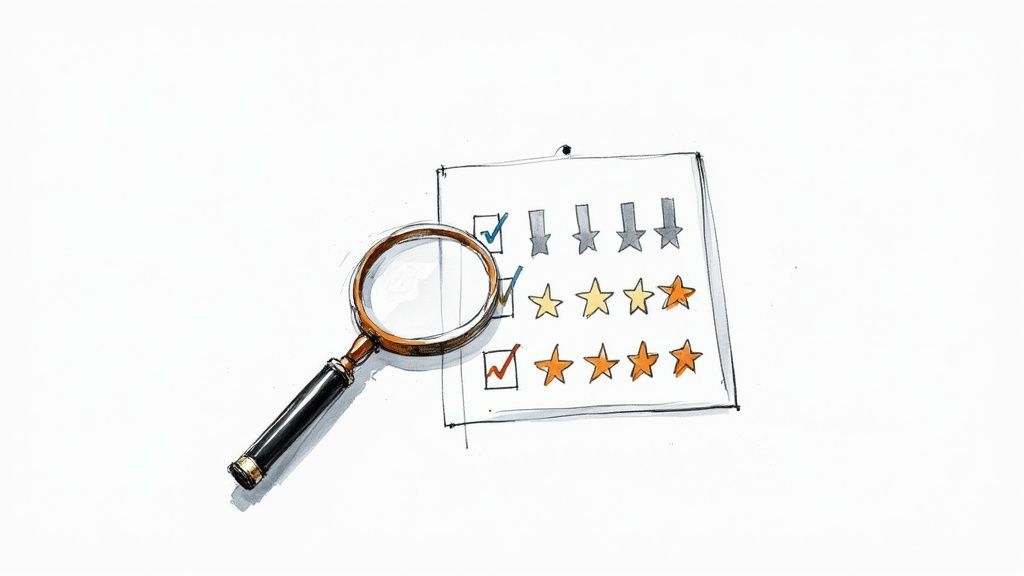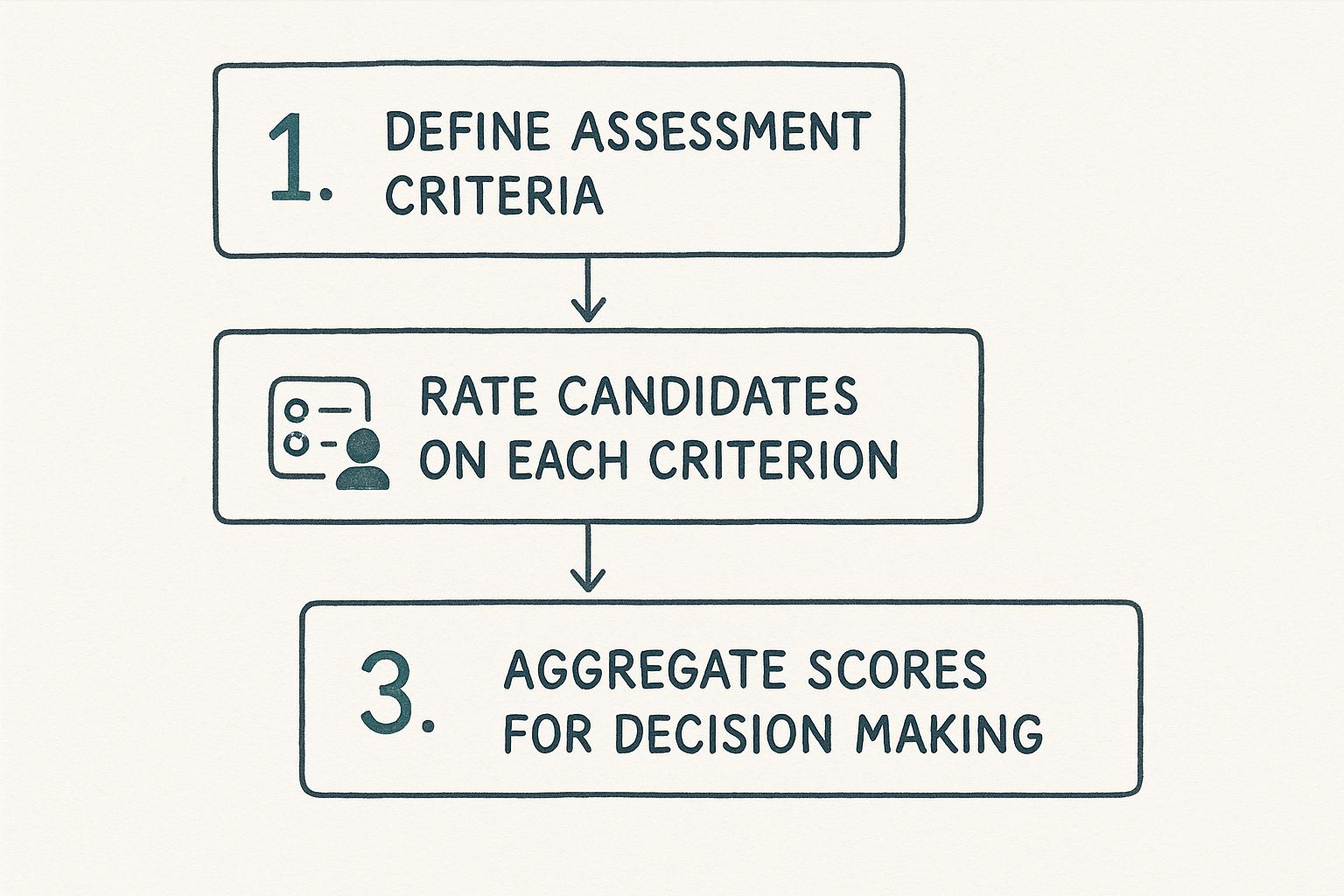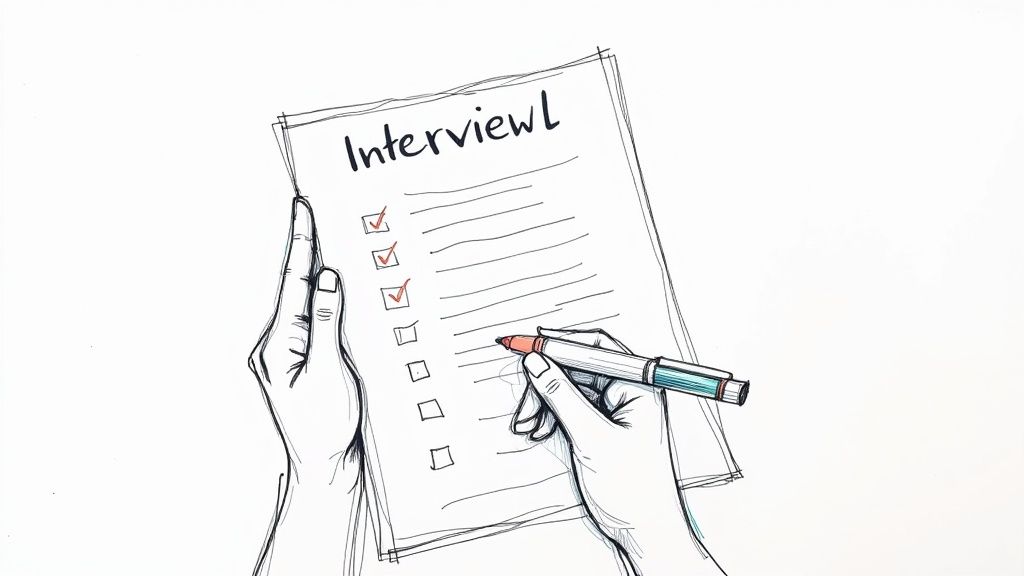October 2, 2025
Create a Better Interview Score Card

An interview score card is a simple yet powerful tool that hiring managers use to evaluate candidates against a pre-set, consistent list of criteria. Think of it as a way to turn subjective, often fuzzy interview impressions into objective, measurable data.
This structure helps cut through the noise, reduce hiring bias, and ultimately improve the quality of your hires. It ensures every single candidate is measured against the same job-relevant skills and qualities.
Move Beyond Gut Feelings in Hiring

Let's be honest. We've all been tempted to hire based on a "gut feeling." While our intuition can be a useful signal, it's often clouded by unconscious biases. We naturally gravitate toward candidates who remind us of ourselves or seem familiar, which doesn't always mean they're the most qualified for the job.
This is where a good interview score card becomes a game-changer. It’s not just another piece of HR paperwork; it's a strategic tool that forces you to define what success in the role actually looks like before you even start interviewing.
The Shift to Skills-Based Decisions
The hiring world is making a big shift toward skills-based evaluation. The focus is now more on what a candidate can do rather than just what their resume says they've done. Standardized questions and a clear scoring system are proven methods for cutting down on bias and making the process fairer for everyone.
This approach lets you zero in on practical abilities and tangible qualifications. You can find more data on how these trends are reshaping the industry on this hiring statistics blog post.
A scorecard provides the perfect framework for this shift. It helps you measure the skills that truly matter, paving the way for data-driven decisions that lead to better hires who stick around.
By quantifying candidate qualifications, you create a defensible and transparent process. This not only protects your organization but also builds trust with candidates by showing that your decisions are rooted in fairness and merit.
Creating a Fair and Consistent Process
Picture this: three different interviewers meet with the same candidate. Without a scorecard, you're likely to get three wildly different opinions. One interviewer might fixate on the candidate’s confidence, another on their technical answers, and a third on a vague sense of "cultural fit."
An interview score card gets your entire hiring team on the same page. It ensures everyone is looking for the same core competencies and using a common language to describe what "good" looks like.
This consistency is the bedrock of an equitable and effective hiring process. If you want to dig deeper into building a system like this, check out our guide on hiring best practices.
Ultimately, the goal is to create a level playing field where every candidate gets a fair shot. The best person for the job should win—not just the one who made the best first impression.
Alright, let's move from theory to practice and actually build your first interview score card. This is where the magic happens—turning a simple job description into a powerful tool that helps your team make smart, objective hiring decisions.
The whole process starts by breaking down the role into its essential parts. What are the absolute must-have skills? And what are the less tangible qualities—like communication or problem-solving—that you know lead to someone thriving on your team? Getting this foundation right is crucial because it ensures your scorecard is directly linked to what success actually looks like on the job.
This simple visual breaks down the flow perfectly: you define what matters, you score the candidates against it, and then you use that data to make your final call.

As you can see, this structured approach takes the guesswork out of hiring and replaces subjective feelings with clear, comparable data.
Figure Out What You’re Actually Measuring
Before you can score anyone, you have to know what you're scoring them on. This is a team sport. Get together with the hiring manager and anyone else who will be involved to decide on the most critical competencies for the role. I find it’s easiest to split these into two buckets.
First, you have the hard skills. These are the technical, teachable abilities someone needs to walk in the door with.
- For a Software Developer: You might list things like proficiency in Python, hands-on experience with AWS, or a deep understanding of agile development.
- For a Marketing Manager: This could be proven expertise with SEO tools like Ahrefs, experience managing a six-figure budget, or advanced skills in Google Analytics.
Then you have the soft skills. These are the interpersonal traits that are tougher to nail down but are often the difference between a good hire and a great one. Think about things like adaptability, collaboration, and how they approach problem-solving. If you don't define these, you're just asking your interviewers to fall back on that fuzzy "gut feeling."
Pro Tip: One of the biggest mistakes I see is creating a laundry list of criteria. Keep it focused. Aim for 5-7 core competencies for any given role. This keeps the scorecard from feeling like a giant checklist and allows the conversation to flow more naturally.
If you need some inspiration for structuring these, checking out some different interview evaluation forms and templates can give you a great starting point.
Create a Rating Scale That Actually Works
A rating scale is pretty much useless if it isn't clearly defined. If one person's "4" is another person's "3," you've just traded one kind of bias for another. The solution is to create what are known as behavioral anchors—short, clear descriptions of what each score looks like in a real interview. This way, everyone on the hiring team is calibrated and using the same standard.
A simple 1-5 scale is usually perfect, but only if every number has a specific meaning attached to it. This is how you turn abstract ratings into concrete, evidence-based observations.
A clear rating scale with descriptive anchors is crucial for consistency. This table shows a sample 5-point scale that interviewers can use to score candidates on various criteria.
Sample Rating Scale for an Interview Score Card
This kind of structure eliminates so much ambiguity. Instead of just circling a number, interviewers have to justify their score based on what they actually heard. That documentation becomes incredibly valuable when the team gets together for the final debrief, because it forces the conversation to be about facts and evidence, not just feelings. Ultimately, the goal is to build a reliable system that leads to fair and defensible hiring decisions every single time.
Anatomy of an Effective Score Card

Let’s be honest, a lot of interview scorecards are little more than a checklist with a 1-to-5 rating scale. That’s a start, but a truly effective scorecard does so much more. It's a tool built to capture the whole candidate—the hard data and the human element.
Think of it this way: a simple rating scale is like a multiple-choice test. It gives you an answer, but not the reasoning behind it. To make your scorecard something you can actually rely on, you need to capture the "why" behind those numbers.
Essential Components Beyond the Ratings
This is where the real magic happens. A great scorecard needs dedicated space for qualitative feedback, allowing your interviewers to add the nuance that a simple number just can't express.
These sections transform a static form into a living record of the conversation.
- Interviewer Notes: This is a free-form space for the interviewer to jot down specific examples, powerful quotes, or just their overall impression. It’s where they can show their work, backing up their scores with real evidence from the conversation.
- Potential Red Flags: You need a designated spot to flag concerns. Maybe the candidate got vague when talking about teamwork, or perhaps they struggled to detail their role in a key project. Documenting these moments ensures they aren't forgotten.
- Overall Recommendation: It’s a simple but vital final verdict. After everything, does the interviewer think this person should move forward? A clear "Yes," "No," or "Maybe" is a powerful, at-a-glance signal for the hiring team.
An interview score card without room for detailed notes is a missed opportunity. The ratings tell you what an interviewer thought, but the notes tell you why. That context is absolutely essential for a productive debrief meeting.
Guiding the Conversation with Targeted Questions
Here’s a pro tip that can completely change your interview game: link specific, open-ended questions directly to each skill you’re evaluating on the scorecard. Suddenly, it’s not just a grading sheet you fill out afterward; it becomes a real-time guide for the interviewer.
For example, instead of a lonely "Problem-Solving" criterion, add a prompt like: "Ask about a time they faced an unexpected obstacle and how they navigated it." This small change ensures every interviewer on the panel is gathering the same kind of evidence for that core competency.
This structured approach is the heart of competency-based interviewing. If you want to really dig in and build a solid framework, it's worth understanding https://www.klearskill.com/blog-post/what-is-competency-based-interviewing in more detail.
Measuring Cultural Contribution Objectively
Finally, let's tackle the elephant in the room: "culture fit." It’s a term that’s often a breeding ground for unconscious bias. A modern, effective scorecard gets rid of it. Instead, we reframe it as "cultural contribution" or "values alignment" and we measure it with objective, behavior-based questions.
Many teams now build a cultural fit assessment directly into their process to move beyond gut feelings and make sure candidates truly align with core company values.
So, instead of a vague criterion like "Good fit," you define what that actually means at your company. Is it a deep-seated commitment to collaboration? A genuine passion for learning and growth? By tying your values to observable behaviors, you can assess this area fairly and build a team that’s truly aligned.
How to Adapt Your Scorecard for Different Roles
A generic interview scorecard is a surefire way to make a bad hire. The skills that make a great junior developer are a world away from what you'd look for in a marketing director. If you want your scorecard to be a genuinely useful tool, you have to tailor it to the specific demands of each job.
This isn't just about swapping out a few keywords on a template. It's about thinking deeply about what success actually looks like for that person, in that role. The basic structure of your scorecard can stay the same, but the criteria—and how much they matter—will need a complete rethink.
Weighing Criteria by Seniority and Function
The real magic of a custom scorecard comes from weighted criteria. For any given job, some skills are simply more important than others. For a senior leadership position, for example, you might decide that strategic thinking and team development make up 60% of the final score.
That same weighting would be completely wrong for a junior developer. For that role, technical ability and specific coding skills should be front and center, maybe weighted as high as 70%. Strategic vision, on the other hand, would be a much smaller piece of the evaluation.
Think about how you'd adjust for different departments:
- Sales Role: You'd want to heavily weigh things like communication skills, resilience, and the ability to negotiate.
- Data Analyst Role: The focus here shifts to analytical thinking, proficiency with tools like SQL or Python, and meticulous attention to detail.
- Project Manager Role: Here, you're looking for top-notch organizational skills, experience with cross-functional collaboration, and a knack for risk management.
By assigning different weights, you're telling your hiring team exactly what to look for and ensuring your evaluation is focused on what truly drives success for that specific job.
Adapting for a Global Talent Pool
Hiring isn't always local anymore. As companies tap into a global talent pool, your scorecard needs to work across borders. This is a huge opportunity—in tech, for instance, 89% of employers are growing their global teams to find the best people. A solid scorecard creates a consistent benchmark, making sure you're applying the same core standards to every candidate, no matter where they are. This consistency is especially important when using tools like video interviewing, which have been shown to be twice as predictive of a candidate's future success. You can see more on this in the latest recruiting statistics.
Of course, you can't ignore cultural context. While your core competencies should remain the same for a role, how you assess them might need some fine-tuning.
Be mindful of communication styles, which can vary significantly across cultures. Frame your questions to be universally understood, and train your interviewers to recognize competencies even when they are expressed differently. The goal is consistency in criteria, not uniformity in candidate expression.
This balanced approach helps you run a fair and equitable process that can pinpoint top talent anywhere on the globe. You're building a framework that's structured enough to be consistent but flexible enough to work for a diverse, global candidate pool. The result is a more inclusive and effective hiring process.
Putting Your Score Card into Practice

Designing a solid interview score card is a great start, but it's consistent use that really makes a difference. A scorecard is only as good as the team using it, which is why you can't just email it out and hope for the best. A proper rollout is key to seeing real results.
Your first step should always be a calibration session with the entire interview panel. This isn't just a quick meeting; it's an essential huddle to get everyone on the same page. Go through each competency on the scorecard and hash out what a "3" versus a "5" actually means in a real interview.
It helps to use hypothetical examples. Ask questions like, "If a candidate describes a project this way, does that earn a 'Strong Yes' or just a 'Yes' for our problem-solving skill?" These conversations are crucial for making sure everyone is using the same yardstick. It prevents that classic problem where one interviewer's "good" is another's "great."
Capturing Fresh and Unbiased Impressions
When it comes to filling out the scorecard, timing is everything. The absolute best practice is for each interviewer to complete their evaluation immediately after each interview. This has to happen before they talk to anyone else about the candidate.
This simple rule is your best defense against groupthink. It ensures you’re capturing each person's genuine, unbiased take. When interviewers wait, their memory fades and hallway chatter can easily influence their original assessment.
Get your team into the habit of blocking off 15 minutes on their calendars right after an interview to fill out the form. It’s a small discipline that makes a huge difference in the quality of your feedback. This way, the data you collect is a pure reflection of that one-on-one interaction, not a watered-down consensus.
A scorecard moves from being a simple form to a powerful decision-making tool when it's filled out with discipline. The goal is to capture pure data from each interview, not a consensus that formed in the hallway chat afterward.
Once the scorecard is in play, knowing how to document and deliver feedback is the next step. This turns raw scores into real insights. Using a model for structured interview feedback can guide your team in translating their notes into clear, constructive communication.
Using Score Card Data for Objective Decisions
Now that you have completed scorecards from everyone, you can compare candidates with a level of clarity you just can't get from memory alone. The combined scores give you a high-level, data-backed view, making it easy to spot who consistently cleared the bar.
During the final debrief meeting, let the scorecard lead the conversation. Instead of starting with a vague, "So, what did we think?" try a more focused approach.
For example: "Let's look at the scores for 'cross-functional collaboration.' John, you gave them a 2. Can you walk us through the evidence that led you to that rating?" This keeps the discussion centered on tangible observations, pushing gut feelings and personal bias to the side.
Frequently Asked Questions About Interview Scorecards
Even with the best scorecard in hand, your team is bound to have questions as they start using it. That’s totally normal. Let's walk through some of the most common scenarios you'll likely run into and how to handle them.
What If Interviewers Disagree on a Candidate's Score?
First off, don't panic. Disagreements are not just normal; they're actually a good thing. A big gap in scores is a flashing sign that you need to talk more. It’s an opportunity, not a problem.
Let's say one interviewer gives a candidate a "2" on collaboration, but another gives a solid "4." This is your cue to bring them together. Ask each person to share the specific things the candidate said or did that led to their rating. The conversation should be about the evidence, not just defending a number.
Key Takeaway: Think of different scores as a conversation starter, not a conflict. You're not trying to force everyone to agree. The real goal is to get all the perspectives on the table so you can make a much smarter, well-rounded final decision.
How Should We Weight Different Criteria?
Every skill isn't equally important for every job, and your scorecard should reflect that. Weighting your criteria is how you make sure you're prioritizing what truly matters for the role. An easy way to do this is by assigning a percentage to each skill or competency, with the total adding up to 100%.
- For a senior engineering role, you might weigh technical skills at 50%, problem-solving at 30%, and communication at 20%.
- But for a customer support role, the priorities flip. Communication might be 50%, problem-solving 40%, and technical knowledge a much smaller 10%.
This simple system makes sure that a candidate who is a rockstar in the most critical areas gets the credit they deserve, even if they aren't as strong in the less important ones.
Can We Still Consider Culture Fit?
This is a tricky one. The term "culture fit" is often a loaded phrase that can easily open the door to unconscious bias. A much better way to think about it is "culture contribution" or "values alignment."
Instead of vaguely asking, "Will they fit in?", you get specific. Define what your company values actually look like in day-to-day behavior, and then build scorecard criteria to measure that.
For instance, if "curiosity" is a core value, you could add a criterion like, "Asks insightful questions and shows a genuine desire to learn." Suddenly, you're not judging someone based on a gut feeling; you're evaluating an observable, concrete behavior. This makes your process fairer and helps you build a team that is both diverse and truly aligned with your company's principles.
Ready to make every hire your best hire? Klearskill uses AI to screen resumes in seconds, eliminating bias and delivering candidates with 95% match accuracy. See how you can reduce screening time by 92% and focus only on the best-fit talent.
